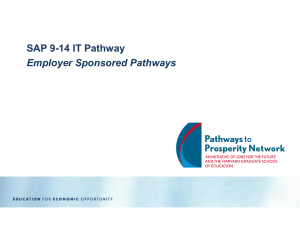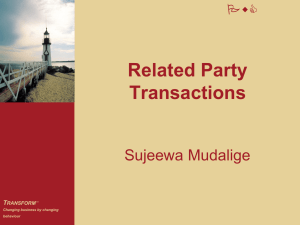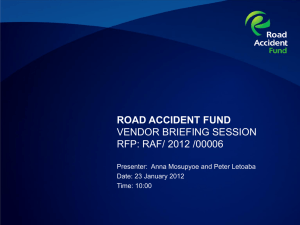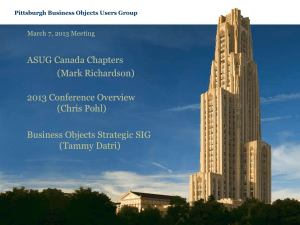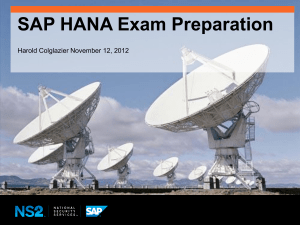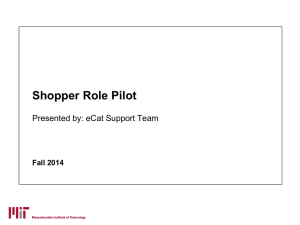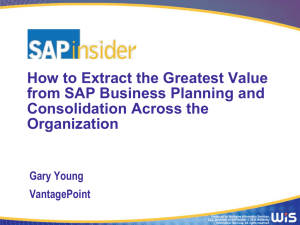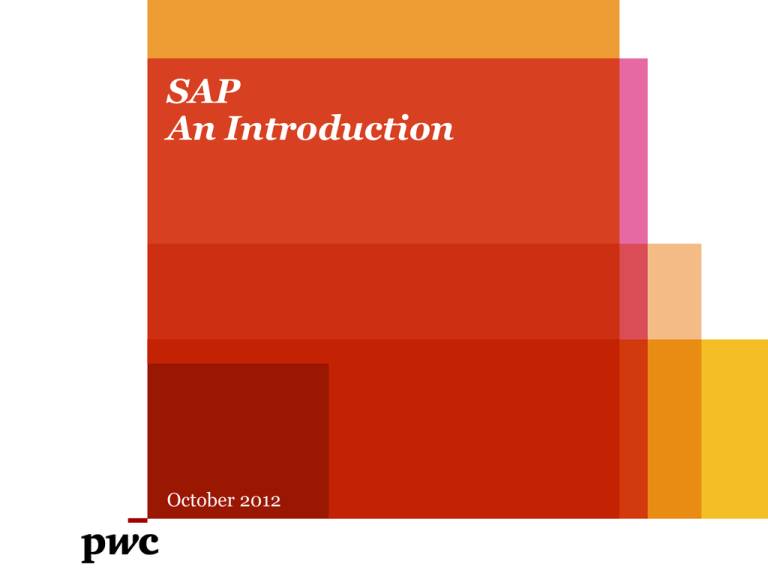
SAP
An Introduction
October 2012
Personal Introductions
Marc Trevino, PwC Senior Associate
– 6 years with PwC
• 6 years working with SAP clients
– 6 years of ISACA membership
– CISA, CPA, CIA
Michael Baker, PwC Senior Associate
– 2 years with PwC
• 2 years working with SAP clients
– CPA
– Currently pursuing CISA
PwC
Agenda
What We Will Do…
• Provide a high level overview of what SAP is
• SAP Authorization Concept
• Provide an introduction to Auditing ITGC’s in SAP
• Segregation of Duties in SAP
PwC
What is SAP?
© 2012 PwC
4
What does SAP stand for?
• Systeme, Anwendungen, Produkte in der Datenverarbeitung
Systems,
Applications and
Products in Data Processing
PwC
What is SAP?
PwC
Integrated
SAP integrates all business processing through one application.
Links operational results and the financial aspects of those results.
Multifunctional
SAP can track financial results, procurement, sales, manufacturing,
human resources and payroll.
Modular
SAP comprises of 18-20 modules in finance, logistics and HR.
One or more SAP modules can be implemented.
Enterprise
Wide
SAP is typically accessible by the entire business organisation.
Most company information and transactions originate from SAP.
“Real Time”
An order in SAP can automatically generate an inventory movement
and a posting in the GL without any “human” intervention.
Overview of an SAP Environment
Presentation Layer
Management
reporting
and end-user
controls
Business process
Controls
(incl. automated,
manual, BPR)
SAP configurable controls
Application Layer
SAP Authorisations/User profiles
SAP Basis Module
Database
Infrastructure
Layer
PwC
Database
Operating System and other Infrastructure controls
IT General
Controls
SAP Instances
PwC
PR1
SAP R/3 or ECC 6.0
PH1
SAP Human Resources
PC3
SAP Customer Relationship Management
PE1
SAP Procurement
PA1
APO Planning
PS1
Solution Manager
PB1
Business Warehouse
SAP Authorization Concept
© 2012 PwC
9
Overview
What is the SAP authorization concept?
Security within SAP is achieved through the authorization concept
The authorization is designed to ensure :
• Maximum security
• Sufficient privileges for end users to fulfil their job duties
• Powerful user maintenance
PwC
Overview
Three levels of security in SAP
User master record
User requires valid
user-ID and password
1
T-code check
User requires an
authorization for
transactions
2
Authority check
User requires an
authorization for
underlying
authorization objects
and field values
PwC
3
SAP Authorization Concept
The components
SAP User Master Record (UMR)
Master data for SAP users
Transaction Code (t-code)
Provides access to specific functions within SAP
Authorization Object:
Template for security that contains fields with blank values (uncut key)
Authorization (Field Values):
Authorization object with completed fields (cut key)
PwC
ME21 – Create
Purchase Order
SAP Authorization Concept
The components
Buyer
Roles
Collection of transaction codes, authorizations and user assignments
Profiles
“Key ring” that contains authorizations (cut keys)
Authority Check
Performed by SAP to ensure that a user ID has the correct authorization object and field
value combination (cut key) to execute a particular task
PwC
R: Display PO
R: Create PO
SAP Authorization Concept
Bringing it all together
•
•
Let’s make an analogy…
… the Lock and the Key
To open the lock, you need the right key!
PwC
SAP Authorization Concept
Bringing it all together
User Master Record
Buyer
R: Display Purchasing document
R: Create Purchase Order (e.g., ME21)
Profile
SAP Security Check
Authorizations
PwC
Auditing ITGC’s in SAP
© 2012 PwC
16
Risk based approach in a SAP environment
SAP is not a typical application / environment split
Many traditional environment functions are provided within the
application including:
» development environment
» change control
» system administration and job scheduling
These functions are collectively known as SAP Basis
Combined with SAP integration, this serves to complicate access
security
PwC
Risk based approach in a SAP environment
SAP allows more comprehensive functionality and control, however,
the following needs to be considered:
− Financial transactions are executed throughout the business
making segregation of duties control key
− The SAP access mechanism is complex making security and
segregation of duties a key risk
− Configuration has a large impact to the overall business process
and controls
PwC
Key IT General Control Domains
•
Consider tests for controls around:
• Access to programs and data
• Changes made to the system (Change management)
• Computer operations
•
Weaknesses identified within the IT general controls can potentially
undermine confirmed and tested automated controls and access controls
at the business process level
PwC
Key Areas within the SAP environment
Access to Programs and Data
•
PwC
Key areas to consider include:
• SAP system settings including password parameters
• Access to user administration functions including defining and
assigning profiles to users (Profile Generator)
• Access to run programs/ transaction codes
• Assignment of SAP_ALL, SAP_NEW, other sensitive profiles
• Default passwords of SAP supplied accounts (SAP*, DDIC,
Earlywatch, SAPCPIC etc.)
• Management and review of User IDs and generic User IDs
• Use of audit logs (SAP Table Logging)
Key Areas within the SAP environment
Change Management
•
PwC
Key areas to consider include:
• Customised programs and tables should be assigned to
appropriate authorisation groups.
• Ability to unlock production environment to make direct changes
to production is restricted and monitored
• Segregation of duties within the change management process
including developer, customizer and approver of the program
change/transport
• Changes to SAP tables and data dictionary in the production
environment is minimized
Key Areas within the SAP environment
Computer Operations
•
PwC
Key areas to consider include:
• Batch jobs and interface processing should be regularly monitored,
with access to amend them restricted
• Batch jobs run under ANOTHER user should be restricted to
appropriate personnel
• Batch jobs run under ANY user should be completely restricted
• Operating and database system administrator access should be
restricted
Auditing SAP
Segregation of Duties Example
© 2012 PwC
23
SOD – Framework – Overview
© 2012 PwC
'Confidential Information for the sole benefit and use of [Global, beverages company].
24
SOD – Framework – SOD/SA Rule
© 2012 PwC
'Confidential Information for the sole benefit and use of [Global, beverages company].
25
SOD – Framework – SOD Rule
© 2012 PwC
'Confidential Information for the sole benefit and use of [Global, beverages company].
26
SOD – Framework – SOD Rule
© 2012 PwC
'Confidential Information for the sole benefit and use of [Global, beverages company].
27
SOD – Framework – Object Level
© 2012 PwC
'Confidential Information for the sole benefit and use of [Global, beverages company].
28
SOD – Framework – Object Level
© 2012 PwC
'Confidential Information for the sole benefit and use of [Global, beverages company].
29
Relationships Between Layers
© 2012 PwC
'Confidential Information for the sole benefit and use of [Global, beverages company].
30
SAP SOD Example
Ability A
Create Maintain Purchase Order
t-code: ME21
Auth Object: M_BEST_BSA
ACTVT: 01
PwC
Ability B
Create Maintain Vendor Master Records
t-code: FK01
Auth Object: F_LFA1_APP
ACTVT: 01
Questions?
© 2012 PricewaterhouseCoopers LLP. All rights reserved. In this document, “PwC” refers to PricewaterhouseCoopers LLP,
which is a member firm of PricewaterhouseCoopers International Limited, each member firm of which is a separate legal entity.
PwC



